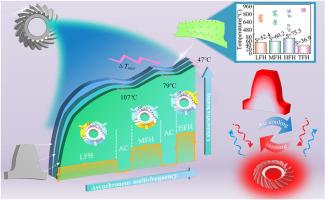Study on the magnetic-thermal evolution and air cooling synergy of bevel gears: based on asynchronous multi-frequency electromagnetic heating
IF 5
2区 工程技术
Q1 ENGINEERING, MECHANICAL
International Journal of Thermal Sciences
Pub Date : 2025-09-06
DOI:10.1016/j.ijthermalsci.2025.110291
引用次数: 0
Abstract
This study proposes an asynchronous multi-frequency heating (TFH) method combined with air-cooling control, revealing the magneto-thermal evolution law in spiral bevel gear heating. Research demonstrates that TFH achieves pulsed thermal excitation on gear surfaces through time-domain modulation of electromagnetic parameters, while the heat flux penetration depth (d) exhibits asymmetric characteristics on bilateral tooth surfaces. A Gaussian eddy-current model incorporating an attenuation term demonstrates that this asymmetry arises from localized eddy-current concentration difference dictated by sharp corner effect driven by tangential edge angle (α). Discrepancies of α at the gear's large end cause 76.3 % greater d on the concave side (smaller α) versus the convex side. Conversely, gradual tooth-profile variations at the small end invert this trend, yielding 85.1 % deeper heating on the convex side. Investigations reveal gradient-distributed air-cooling rates at tooth tip, middle, and bottom sections during frequency switching, with this dynamic thermal dissipation behavior effectively compensating temperature differentials induced by gradual tooth-profile variations. The bi-directional dispersion degree of the tooth surface temperature (S), as a temperature uniformity metric, demonstrates a 60 % reduction when using TFH compared to single-frequency methods, indicating the significant advantage of this strategy in achieving uniform heating for complex workpieces.

基于异步多频电磁加热的锥齿轮磁热演化与风冷协同研究
提出了一种结合风冷控制的异步多频加热(TFH)方法,揭示了螺旋锥齿轮加热过程中的磁热演化规律。研究表明,TFH通过电磁参数的时域调制在齿轮表面实现脉冲热激励,而热流通量穿透深度(d)在双齿表面呈现不对称特征。一个包含衰减项的高斯涡流模型表明,这种不对称性是由切向边缘角(α)驱动的尖角效应所决定的局域涡流浓度差引起的。齿轮大端α的差异导致凹侧d比凸侧大76.3% (α较小)。相反,在小端逐渐变化的齿廓变化扭转了这一趋势,在凸侧产生85.1%的深度加热。研究表明,在频率切换过程中,齿尖、中间和底部的空气冷却速率呈梯度分布,这种动态散热行为有效地补偿了齿形逐渐变化引起的温差。齿面温度的双向分散程度(S),作为温度均匀性指标,表明与单频方法相比,使用TFH时降低了60%,表明该策略在实现复杂工件均匀加热方面具有显着优势。
本文章由计算机程序翻译,如有差异,请以英文原文为准。
求助全文
约1分钟内获得全文
求助全文
来源期刊

International Journal of Thermal Sciences
工程技术-工程:机械
CiteScore
8.10
自引率
11.10%
发文量
531
审稿时长
55 days
期刊介绍:
The International Journal of Thermal Sciences is a journal devoted to the publication of fundamental studies on the physics of transfer processes in general, with an emphasis on thermal aspects and also applied research on various processes, energy systems and the environment. Articles are published in English and French, and are subject to peer review.
The fundamental subjects considered within the scope of the journal are:
* Heat and relevant mass transfer at all scales (nano, micro and macro) and in all types of material (heterogeneous, composites, biological,...) and fluid flow
* Forced, natural or mixed convection in reactive or non-reactive media
* Single or multi–phase fluid flow with or without phase change
* Near–and far–field radiative heat transfer
* Combined modes of heat transfer in complex systems (for example, plasmas, biological, geological,...)
* Multiscale modelling
The applied research topics include:
* Heat exchangers, heat pipes, cooling processes
* Transport phenomena taking place in industrial processes (chemical, food and agricultural, metallurgical, space and aeronautical, automobile industries)
* Nano–and micro–technology for energy, space, biosystems and devices
* Heat transport analysis in advanced systems
* Impact of energy–related processes on environment, and emerging energy systems
The study of thermophysical properties of materials and fluids, thermal measurement techniques, inverse methods, and the developments of experimental methods are within the scope of the International Journal of Thermal Sciences which also covers the modelling, and numerical methods applied to thermal transfer.
 求助内容:
求助内容: 应助结果提醒方式:
应助结果提醒方式:


